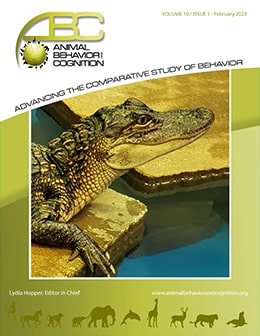Vol 10, Issue 1, February 2023
Problem-Solving and Spontaneous Tool-Using Ability in European Brown Bears (Ursus arctos arctos)
Citation
Chambers, H. R., & O’Hara, S. J. (2023). Problem-solving and spontaneous tool-using ability in European brown bears (Ursus arctos arctos). Animal Behavior and Cognition, 10(1), 40-61. https://doi.org/10.26451/abc.10.01.03.2023
Abstract
Little is known about the cognitive abilities of bears, despite possessing relatively large brains for their body size. One reason this group is perhaps overlooked is because they are thought to fail to conform to the “social brain” hypothesis, by being relatively solitary species but still possessing large brains. Here, to better understand the proposed benefits afforded by encephalization, the cognitive abilities of 17 captive European brown bears Ursus arctos arctos were tested. The aim was to determine whether bears possess problem-solving and object-manipulation abilities. Two experimental tests – a puzzle box and an object-manipulation set-up – were presented to bears at seven UK zoological parks. Generalised linear mixed models were used to determine which variables, specifically age, sex, motivational levels, behavioral diversity and persistence, influence cognitive performance. Results revealed evidence of trial-and-error learning; however, two juveniles appeared to acquire a latch association, suggesting some individuals have potential to adopt successful strategies and draw perceptive associations. Individual variation in motivation levels appears to be an important factor influencing cognitive performance. Overall, the bears failed to spontaneously use a tool but still managed to retrieve the food reward, instead using alternative techniques to solve the problem. Analyses revealed both age and sex to be negatively associated with time-to-solve in our sample, indicating the younger male bears solved the task more quickly. Results suggest social dynamics of group-living bears to be influencing cognitive performance, as the collective nature of testing resulted in increased competition over a high-value reward. These results are discussed herein. Brown bears are confirmed to be an excellent model species for testing the cognitive abilities of Ursids, as well as theories of cognitive evolution.
Keywords
Bears, Brain size, Problem-solving, Object-manipulation, Intelligence, Tool use
